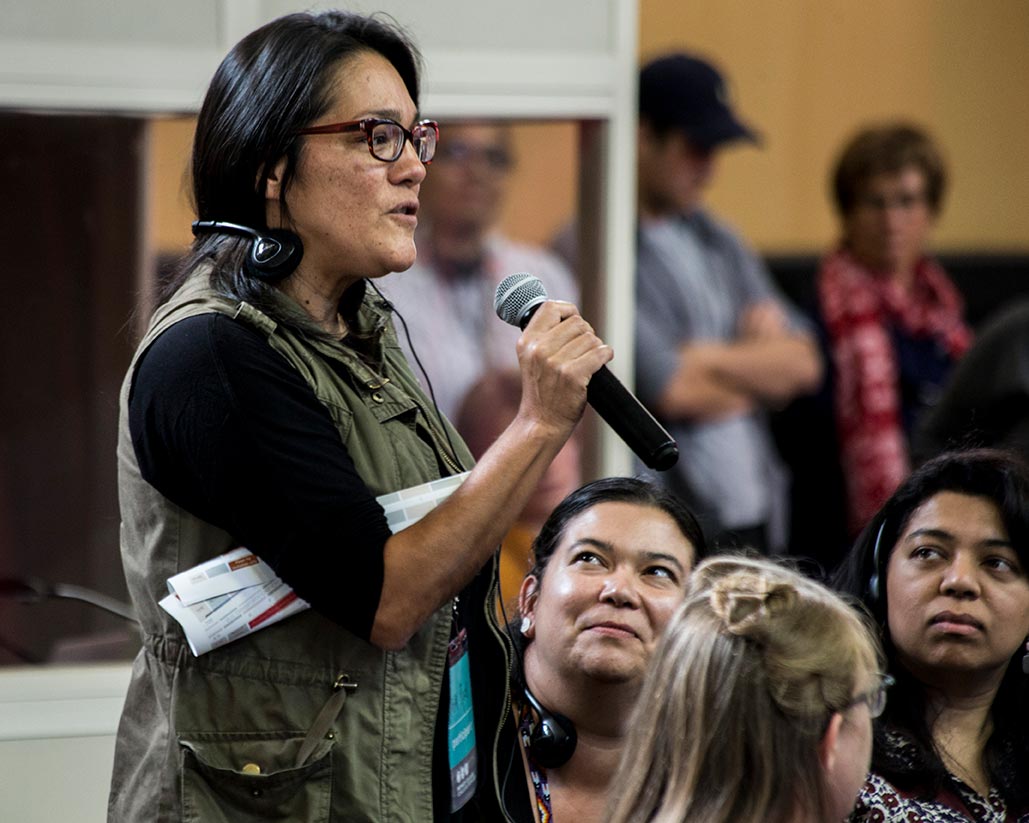 Kathia Rock at the PC/Cp Gathering 2017 on Lekwungen
Kathia Rock at the PC/Cp Gathering 2017 on Lekwungen
territory. Photo credit: Kirk Schwartz.
The question “What is a Quebec artist?” was aimed at exploring identity and identification issues.
My name is Kathia Rock and I’m a singer-songwriter from the Innu Nation. I’m also an actor. For me, Montreal is my second “great reserve,” where I can fulfill myself as an artist. I have lived there for 34 years and followed a personal artistic journey in order to further my learning process.
On Lekwungen territory in September 2017, I was invited to join this great gathering to discuss the general issues and challenges facing the arts sector.
Montreal is a city where you can see all kinds of shows. However, Indigenous productions are limited and very few are invited to take part. The City’s major festivals come to mind.
My proposed workshop was “Who is considered a Quebec artist from the perspective of the Quebec arts community?”
In my humble opinion, “dyed in the wool” Quebecers are an integral part of the Quebec arts scene. As for new arrivals, visible minorities or aboriginals, we’re only called upon in the case of needing to meet special requirements or a hiring percentage. Unfortunately, in certain disciplines like music, Bill 101 hurts other cultures, including First Nations, if they sing in their mother tongue. Having been born in Quebec, I’m well placed to talk about language protection. However, I still don’t understand why my native language is excluded or why I’m considered part of the world music scene.
What were the questions, issues and challenges?
When I left my community, my big dream was to perform on numerous stages in Quebec, collaborate with other artists and help promote Indigenous culture. As the years went by, I soon realized that I was invited to perform only when there was a need for a “First Nations Artist” box or a show opener. This impression was confirmed one day when I wanted to register in a singer-songwriter contest… and was refused because I didn’t sing in French.
Who receives grants?
Anyone can, especially since the federal government increased the budget for Aboriginals. For the past year, the watchword has been “reconciliation” or “include an Indigenous person in your production and your budget will double.” Imagine the offers for 4th assistant or 3rd or 4th non-speaking roles.
Who has access to resources and infrastructures?
We only have access to a small share of these resources or infrastructures, again due to Bill 101.
Who is celebrated at galas?
The first Aboriginal artists to make an appearance at an ADISQ[1] gala were the duo Kashtin. Then for several years, nothing. Next came Elisapie, and then Samian, who spoke a few words in Algonquin or Inuktitut. Otherwise, our music is considered world music in our own province.
Who is seen on TV?
Whether on television, in the theatre or in feature films, our roles are informed only by stereotypes. My culture is basically a barrier.
Who is part of public collections?
??
Who is featured in museums and galleries?
No painters that I know.
Who is published? What place is given to aboriginal artists and artists of colour (immigrants or from communities of colour)?
Not for me to say. It’s not my department.
Who has the right to call oneself a Quebecer?
We all have the right to call ourselves Quebecers, except that we’re categorized only as visible minorities
Who feels like a Quebecer?
I was born and raised in Quebec and am governed by the federal government; I consider myself a Quebecer.
Translated by Elizabeth Vincent.

Kathia Rock. The musical universe of this Innu of Maliotenam is theatrical and tinged with poetry. She is inspired by both the urban planner and community life. Her warm voice accompanies melodies that draw their sources from the ancestral repertoire of his people and contemporary music. Photo credit: René Bellefeuille